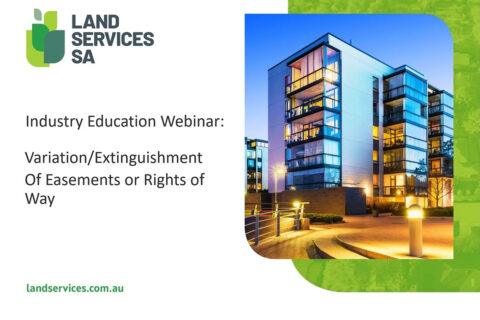Need assistance?
Land Services SA is unable to provide legal advice. Whilst you are not obligated to engage the services of a solicitor or registered conveyancer, Land Services SA always recommends engaging an industry professional to seek representation due to the complex legal nature of land transactions / dealings, subdivisions and boundary realignments.
The best way to find an Industry Professional is through a recommendation by a friend or family. Alternatively, Industry Bodies publish lists of registered and certified practitioners in your areas.
An easement gives an individual or a company (grantee), the right to use land for a specific purpose. An easement can restrict how the owner of the land (grantor) can use their property.
Common easements include:
- pathways and walkways
- for the supply of utilities – e.g. water, electricity, gas, sewerage
- access roads (free and unrestricted rights of way / rights of ways)
- the right to park a vehicle
- party walls
Easements and rights of way that are registered on a certificate of title will remain as the land is bought and sold. It can only be removed when both the easement holder and the owner of the land agree to it. Some easements may not be listed on the certificate of title – e.g. electricity, sewerage and water, telecommunication easements.
Have a look at the Land Services SA Factsheet on Easements in Gross for more information.
If SA Water has a sewer pipe positioned under your land it is likely they will have an easement on your property. This entitles them to access the land to repair, maintain or replace this pipe.
Have a look at the Land Services SA Factsheet on Easements and Rights of Way for more information.
Training Material for Industry Professionals
The following document and webinar has been developed to assist Industry Professionals when dealing with Easements.
Grant of Easement (TG) – Preparation Notes PDF 621 KB
Webinar
Easements

How to Prepare an Extinguishment/Variation of Easement (VE Dealing)
Presenters John Ikonomopoulos, Sandy Beaglehole and Jaymie Heinrich
How an Easement can Affect Property
There may be restrictions placed on how you can use the property and the land the easement covers. This can include building on the easement. When applications for development approval are lodged, any registered easements will be taken into consideration.
You may not be able to build in an area that would restrict access to the easement, or to fence off a right of way to prevent access. Other types of restrictions may apply – e.g. you may not be able to plant certain types of trees on or near a water pipe.
If your property holds an easement over someone else’s land this could be a benefit that may increase the value of your property. If you don’t check the easements on your property and the restrictions associated with it when you build you will be held responsible for organising and paying for the structure to be removed, and repairing any damage caused.
How to Find out if an Easement is Registered
You can purchase a Register Search Plus product through SAILIS – this will provide you a copy of the certificate of title which would provide information about any easements and their location on the property, and a copy of the plan which will show the exact location of the easement.
You can contact the easement holder for more information on its size and location or you can engage the services of a professional surveyor to locate and measure the easement on the property.
If you are planning to buy a property your registered conveyancer or solicitor will be able to locate information on your behalf about any easements registered. This information will also be included in the buyer’s information notice and the vendor’s statement that the vendor or their agent will provide. You should carefully consider all the potential implications of an easement on a property before you sign the contract of sale.
Getting an Easement Registered, Changed or Removed
It is strongly recommended that you engage the services of a registered conveyancer or solicitor if you intend to register, remove or change an easement.
As a land owner you can refuse a request to register an easement but in rare circumstances some statutory bodies – e.g. SA Water, can register an easement without your permission.
Register an Easement
An easement is registered by completing a grant of easement form and lodging this, together with the applicable fee, with Land Services SA.
When an easement is first created you may be able to negotiate for compensation from the grantee. Once an easement is registered you can’t refuse the grantee the use of, or access to, the easement.
Change or Remove an Easement
An easement can only be changed or removed when both you and the grantee agree to it. If no agreement between the grantor and grantee can be reached the matter can be taken to court for a decision.
To have an easement removed or changed complete an application to extinguish or vary an easement and lodge this, together with the applicable fee, with Land Services SA.

